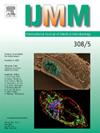巴基斯坦开伯尔-普赫图赫瓦省多药耐药结核病中吡嗪酰胺和氟喹诺酮类药物耐药性的基因组分析。
IF 3.6
3区 医学
Q1 MICROBIOLOGY
引用次数: 0
摘要
背景:由结核分枝杆菌复合体(MTBC)细菌引起的结核病(TB)仍然是全球健康挑战,多重耐药(MDR)和广泛耐药(XDR)菌株加剧了结核病的威胁。目的:本研究采用全基因组测序(WGS)来表征KPK耐多药结核分离株中与吡嗪酰胺(PZA)和氟喹诺酮(FQ)耐药相关的基因突变。方法:在生物安全三级条件下,在省结核病参考实验室收集耐多药和广泛耐药前结核样本并进行处理。样品进行显微镜检查、GeneXpert MTB/RIF检测、培养和药敏试验。从阳性培养物中提取DNA并进行WGS。使用生物信息学工具分析测序数据,鉴定耐药性相关突变,并评估分离株之间的遗传多样性。结果:在分析的78株MTBC分离株中,67株(85.9 %)被确定为耐多药结核病,48株被归类为前xdr, 11株对药物敏感。分离株主要来自年轻患者(平均年龄29.5岁,SD±12.64),女性患者比例较高(61.53 %)。在51株分离株中发现了与PZA耐药相关的pncA基因突变。对氟喹诺酮类药物的耐药性与48个分离株中gyrA和gyrB基因的突变有关。WGS证实51株PZA耐药,其中39株(76.47 %)对FQ耐药。结论:系统发育分析显示,谱系3 (L3)占优势(58.97 %),其次是L4、L2和L1菌株。L3内耐药菌株的聚集表明正在进行局部传播。这些发现强调迫切需要有针对性的干预措施,包括加强分子监测和量身定制的治疗策略,以在KPK对抗耐多药结核病。本文章由计算机程序翻译,如有差异,请以英文原文为准。
Genomic insights into pyrazinamide and fluoroquinolone resistance in multidrug-resistant tuberculosis in Khyber Pakhtunkhwa, Pakistan
Background
Tuberculosis (TB), caused by bacteria of the Mycobacterium tuberculosis complex (MTBC), remains a global health challenge, exacerbated by multidrug-resistant (MDR) and extensively drug-resistant (XDR) strains.
Objectives
This study employs whole-genome sequencing (WGS) to characterise genetic mutations associated with pyrazinamide (PZA) and fluoroquinolone (FQ) resistance in MDR-TB isolates from KPK.
Methodology
MDR and pre-XDR TB samples were collected and processed at the Provincial Tuberculosis Reference Laboratory under Biosafety Level III conditions. Samples underwent microscopy, GeneXpert MTB/RIF assay, culture, and drug susceptibility testing. DNA was extracted from positive cultures and subjected to WGS. Bioinformatics tools were used to analyse sequencing data, identify resistance-associated mutations, and assess genetic diversity among isolates.
Results
Out of the 78 MTBC isolates analysed, 67 (85.9 %) were identified as MDR-TB, with 48 categorized as pre-XDR, while 11 were drug-susceptible. The isolates predominantly came from young patients (mean age: 29.5 years, SD ±12.64), with a higher proportion of female patients (61.53 %). Mutations in the pncA gene, associated with PZA resistance, were identified in 51 isolates. Resistance to fluoroquinolones was linked to mutations in the gyrA and gyrB genes in 48 isolates. WGS confirmed PZA resistance in 51 isolates, 39 (76.47 %) of which also exhibited FQ resistance.
Conclusion
Phylogenetic analysis revealed that Lineage 3 (L3) was predominant (58.97 %), followed by L4, L2, and L1 strains. The clustering of drug-resistant strains within L3 suggests ongoing localized transmission. These findings underscore the urgent need for targeted interventions, including enhanced molecular surveillance and tailored treatment strategies, to combat MDR-TB in KPK.
求助全文
通过发布文献求助,成功后即可免费获取论文全文。
去求助
来源期刊
CiteScore
9.70
自引率
0.00%
发文量
18
审稿时长
45 days
期刊介绍:
Pathogen genome sequencing projects have provided a wealth of data that need to be set in context to pathogenicity and the outcome of infections. In addition, the interplay between a pathogen and its host cell has become increasingly important to understand and interfere with diseases caused by microbial pathogens. IJMM meets these needs by focussing on genome and proteome analyses, studies dealing with the molecular mechanisms of pathogenicity and the evolution of pathogenic agents, the interactions between pathogens and host cells ("cellular microbiology"), and molecular epidemiology. To help the reader keeping up with the rapidly evolving new findings in the field of medical microbiology, IJMM publishes original articles, case studies and topical, state-of-the-art mini-reviews in a well balanced fashion. All articles are strictly peer-reviewed. Important topics are reinforced by 2 special issues per year dedicated to a particular theme. Finally, at irregular intervals, current opinions on recent or future developments in medical microbiology are presented in an editorial section.

 求助内容:
求助内容: 应助结果提醒方式:
应助结果提醒方式:


